Powerdynamo brings new ignition & light
to your vintage motorcycle
|
|
Powerdynamo brings new ignition & light |
|
|||
| Assembly instructions for system 73 66 499 00 and 73 66 499 EE |
Version 03.01.2014 |
|
If you can install your stock dynamo/alternator and
possess basic mechanical skills, you can install a Powerdynamo! |
|
| Powerdynamo can not monitor the compliance to those instructions, nor the conditions and methods of installation, operation, usage and maintenance of the system. Improper installation may result in damage to property and possibly even bodily injury. Therefore we assume no responsibility for loss, damage or cost which result from, or are in any way related to, incorrect installation, improper operation, or incorrect use and maintenance. We reserve the right to make changes to the product, technical data or assembly and operating instructions without prior notice. | |
|
|
Please read these
instructions fully and carefully before starting work on your motorcycle Please bear in mind that any modification of the material as well as own repair attempts which have not been agreed with Powerdynamo may result in a loss of warranty. Do not cut off wires. This leads to a loss of reverse polarity protection and often results in damage to electronics. Also, please take note of the information provided on the information page for this system. Check that what you have bought really corresponds to the motorcycle you have. During assembly check carefully that the rotor (flywheel) does not touch the stator coils or anything else, which may happen due to various circumstances and lead to severe damage. |
| Designated use This system is designated to replace stock dynamo/alternator in vintage and classic motorcycles. As it is a voltage generating unit only, it will in not change your engine characteristics. In most cases it will supply more electric power and hence enhance roadworthiness and comfort by offering better lighting, better function of side indicators and horn and, compared with the aging stock systems, increased reliability.
The system does not replace your ignition. Ignition must be either a compleately selfsupplying magneto
or there has to be a battery in the system. The system has not been tested to work with a third party
electonic ignition. it may work with it, but also may not and even may damage it.
At any rate the system will charge your battery well.
This is a replacement system and not a copy of the stock material. The parts in this system therefore look different and might fit differently (notably ignition coil and regulator) requiring some adaptation by you. |
|
| During assembly imperatively start with assy of engine based parts to see that those really fit before you start fitting the external parts. In many cases customers assemble those first and thereby often modify them in breach of warranty which renders them unfit for renewed sale. Replacing old electrical systems is not a matter of taking something from a supermarket shelf as there have been very many types, versions and possibly unknown aftermarket modifications which harbour plenty of room for error. | |
| Our systems are NOT tested for use with third party electronic devices (such as GPS, mobile phones, LED lighting or electronic ignition)and may cause damage to such parts. Possibly existing electronic tachometers will not work with the new system. Read our information for suitable solutions. Possibly existing safety switches and electronic valve controls are not supported. | |
| If you have no expertise for the installation have it done by an expert or at a specialist's workshop. Improper installation may damage the new system and your motorcycle, possibly even lead to bodily harm. | |
| Before you order a system, please check whether a puller
tool for the new rotor is included in the kit. If not,
better order it at the same time. You might want to order light bulbs,
fuse, horn,
flasher
unit etc. Never use anything other than the recommended puller tool to pull the new rotor again. Damage to the rotor as a result of use of other tools or methods is not covered by warranty. |
|
| The rotor is sensible to blows (including during transport). Before assembly, please always check for damage (on rotor without magnet plastification try to push the magnets aside with your fingers). After impact the glued in magnets might have broken loose, sticking to the rotor solely by magnetic force, so that one does not notice right away. During engine run the damage would be considerable. Before placing the rotor onto the engine, please make sure that its magnets have not collected any metal objects such as small screws, nuts and washers. That equally would lead to severe damage. | |
| If you have access to the Internet, best view those instructions online. You get larger and better pictures by clicking onto them and possibly updated information. System list at http://www.powerdynamo.biz | |
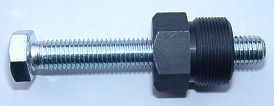 |
To disengage your new rotor again, please use only
the puller, not supplied with the kit.
Note: Never use a claw puller, a hammer or any other device, that will shake the magnets off. |
|
|
|
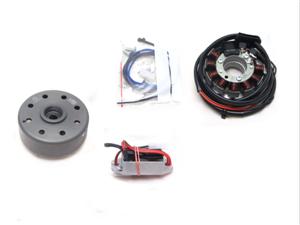 |
You should have received those parts!
|
|
|
|
| Make sure your motorcycle rests securely, preferably on an elevated work bench and that you have good access
to the generator side of the engine.
Disconnect your battery and take it out of the motorcycle. Note, that you will install a 12 volts system, so you will either need a 12 volt battery or you use the option of driving without. You will still have to replace all lightbulbs to 12 volt ones. The horn may stay at 6 volts. |
|
|
|
|
|
In a
first step, |
Unscrew the generator cover and take it off.
Disconnect the wires from the old magneto.
Pull all wires out of the engine housing, but do not cut any wires yet.
Pull the old rotor with a corresponding puller. Unscrew the old stator (2 screws) and take it off the engine. Pull the rotor off, you will need a puller screw for this. Disconnect the wires from your old ignition coil and remove the coil. The ignition parts at the right side of your engine (points and govenor) will not be used anymore. You may leave them there or remove them. |
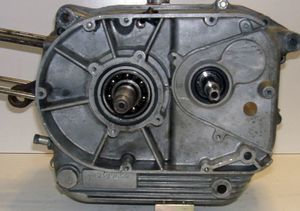
|
|
|
|
|
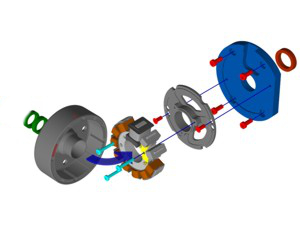 |
The new stator unit has of 2 plates.
Take the 3 pre-assembled hex screws M6 off and pull the stator a little away from the base (to get access to the screws). |
|
|
|
| Place the bottom adapter onto the engine, do not forget to use a new gasket and/or some liquid gasket. Remember that this will seal your crankcase. Screw it down carefully, tightening screws carefully and crosswise. Make sure not to damage the oilseal. | |
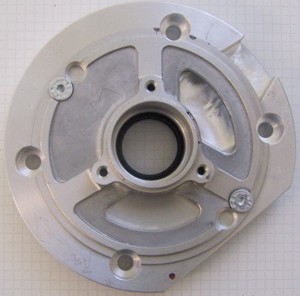 |

|
|
|
|
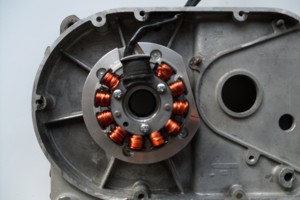
|
Place the statorbase onto the adapter now fixed to
the engine. Screw the plate down with the 2 supplied countersunk screws M5x14. Put the stator coil back onto the plate, take care not the damage the wires. Make sure that the inner opening of the stator unit slots evenly over the elevated fixing rim of the base plate. Screw the coil down with the 3 hex screws M6x30 and tighten. |
|
|
|
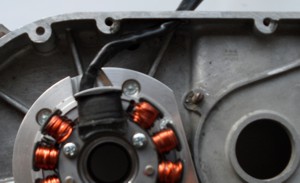 |
Lead the wire out of the wire exit of the engine. Depending on diameter there you might have to enlarge the hole a little. Put a rubber grommet for protection. |
|
|
|
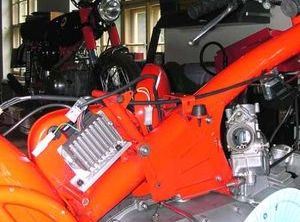 |
Now the new regulator/rectifier have to find a place on the motorcycle. The regulator is well dimensioned and does not need to put it into direct airflow. Here in picture shows a proposition of where to fix the part. |
|
|
|
|
Connect the parts as shown in wiring diagram g-only-102: |
||
|
* |
To facilitate wire exit through the often small openings in the engine casing, the plastic plug of the generator's wiring that leads to the ignition coil has not been put onto the wire terminal. You should place the plug there only once all has been properly installed on the engine side. | |
|
* |
|
The new regulator/rectifier has 4 wires
|
| The two black cables leading from the generator ... |
... should be first introduced into the supplied twin plastic plug housing. This housing connects to the plastic plug at the end of the 2 black wires on the regulator. It does not matter which black is at which side, as there is AC. |
|
| The brown cable from the regulator ... |
... should connect to either battery minus or good ground if there is no battery. |
|
|
The red cable from the regulator ... Take care: |
... should connect to either battery 12V PLUS or if there is no battery to the wiring that runs to your consumers (normally main switch intake pin). |
|
| If you use a battery, make sure that you have a 10A-fuse between battery and vehicle circuitry. | ||
|
There is NO facility for a charge control light without battery this will not work anyway. The regulator has an inbuilt high potency condenser to smoothen voltage. This will make sure that your side indicators (flashers) and horn will work correctly even without battery. |
||
| * |
Remains the blue (sometimes blue/white) wire at the ignition coil. This is the kill (cut-off) wire.
Note: |
Connected to ground - it
will stop ignition!
This type of wiring is used in motorcycles which originally already had magneto ignition and therefore switched off by shortcircuiting against ground. Those vehicles have by design a main lock (or some kill switch) that connects a pin to ground when in OFF position (German bikes: pin 2). The blue(/white) wire of the ignition coil will be connected here. In that way the cut-off works like previously. |
| * |
Screw the high tension (ignition) cable ...
Please do not use any spark amplifying cables, such as "Nology supercables" or "hot wire". This will disturb the system and possibly damage it. |
... into the ignition coil and pull over the rubber seal before
mounting the
coil (it will be easier).
Please do use the cable arriving with the pack and not any old cable. |
|
You will do yourself a favour to treat your bike to new spark plugs and
spark plug sockets (preferably some between 0-2kOhm).
Plenty of problems are to be traced back to "apparently good" (even
completely "brand-new") sparks plugs, terminals and cables. Do not use spark plugs with an intern suppression resistor. NGK (e.g.) offered such spark plugs coded with an "R" (for resistor). |
||
|
* |
Finally - and before installing the battery and before the first kickstart - please re-check carefully all connections and fitments against the wiring diagram. Do check battery and light bulbs for correct voltage (12V). Should something not work, please consult our trouble-shooting guide on our homepage. As a first step disconnect the blue wire from the coil and re-test. |
|
| * |
IMPORTANT: During crank shaft repair the dynamo shaft is often
machined and gets shorter. The result is a rotor sitting lower, possibly
touching now with its rivets the stator coil. The result is a destroyed
stator and ignition failure. For more detail and how to check see (online) here. |
|
|
|
Important safety and operating information for dynamo only systems |
|
# |
Safety first! Please observe the general health and safety regulations motor vehicle repair (MVR) as well as the safety information and obligations indicated by the manufacturer of your motorcycle. |
|
# |
After installation, please check tightness of all screws. If parts get loose during run, there will be inevitably damage to the material. We pre-assemble screws only loosely. |
|
# |
Give the newly installed dynamo a chance to work, before you start
to check and test. Our parts have been checked before delivery to you. You will not be able to check much anyway. At any rate do refrain from measuring the electronic regulator other than the output voltage. You risk several damages to the inner electronic there. You will not get any tangible results from the operation anyway. Check ground connections carefully and, to be on the safe side and for testing, put an additional ground wire from the regulator directly to the engine block. |
|
# |
Never do electric arc welding on the bike without completely disconnecting all parts containing semiconductors (ignition coil, regulator, advance) stator and rotor need not be taken off. |
|
# |
Electronics are very sensitive to wrong polarity. After work on the system, do check correct polarity of the battery and the regulator. Wrong polarity creates short circuits and will destroy the regulator which is for negative earth only. |
|
# |
When you handle the new rotor, take care not to damage its magnets. Refrain from direct blows to the circumference of the rotor. When transporting never put the rotor over the stator. Observe our information relative to transport of the material. |
|
# |
It is a good idea to cover the rotor in a thin layer of oil to reduce the risk of corrosion. |
|
# |
Never use a claw puller or a hammer to disengage the rotor. Its magnets might become loose in the event. We offer a special puller screw for disengaging the new rotor again (see assembly instruction)! |
|
# |
Should the motorcycle not be in use for some longer period, please disconnect the battery (so existing) to prevent current bleeding through the diodes of the regulator. Though, even a disconnected battery will empty itself after a while. |
|
# |
Please do observe those remarks, but at the same
time, don't be afraid of the installation process. Remember, that before you, thousands of
other customers have successfully installed the system. Enjoy driving your bike with its new electric heart! |